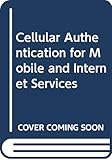Cellular authentication for mobile and Internet services / Silke Holtmanns ... [et al.].
Contributor(s): Holtmanns, Silke | IEEE Xplore (Online Service) [distributor.]
| IEEE Xplore (Online Service) [distributor.] | Wiley [publisher.]
| Wiley [publisher.] .
.
Material type:  BookPublisher: Chichester, UK : Wiley, 2008Distributor: [Piscataqay, New Jersey] : IEEE Xplore, [2008]Description: 1 PDF (x, 204 pages).Content type: text Media type: electronic Carrier type: online resourceISBN: 9780470771013.Subject(s): Mobile communication systems -- Access control
BookPublisher: Chichester, UK : Wiley, 2008Distributor: [Piscataqay, New Jersey] : IEEE Xplore, [2008]Description: 1 PDF (x, 204 pages).Content type: text Media type: electronic Carrier type: online resourceISBN: 9780470771013.Subject(s): Mobile communication systems -- Access controlIncludes bibliographical references and index.
Preface. -- Acknowledgements. -- 1. Introduction. -- 1.1. Authenticated Key Agreement. -- 1..1. The Challenge in Authenticated Key Agreement. -- 1.3. How to read This Book? -- 2. Classical Approaches to Authentication and Key Agreement. -- 2.1. Existing Mobile Security Solutions. -- 2.2. General-Purpose Approaches to Authentication and Key Management. -- 2.3. Requirements for GAA. -- 3. Generic Authentication Architecture. -- 3.1. Overview of Generic Authentication Architecture. -- 3.2. Foundations of GAA. -- 3.3. Variations of the Generic Bootstrapping Architecture. -- 3.4. Building Blocks of GAA. -- 3.5. Other Architectural Issues. -- 3.6. Overview of 3GPP GAA Specifications. -- 4. Applications Using Generic Authentication Architecture. -- 4.1. Standardized Usage Scenarios. -- 4.2. Additional Usage Scenarios. -- 5. Guidance for Deploying GAA. -- 5.1. Integration with Application Servers. -- 5.2. Integration with OS Security. -- 5.3. Integration with Identity Management Systems. -- 5.4. Integration of GAA into Mobile Networks. -- 6. Future Trends. -- 6.1. Standardization Outlook. -- 6.2. Outlook for GAA. -- Terminology and Abbreviations. -- Index.
Restricted to subscribers or individual electronic text purchasers.
An invaluable reference discussing the Generic Authentication Architecture (GAA), its infrastructure, usage and integration into existing networks Cellular Authentication for Mobile and Internet Services introduces the reader into the field of secure communication for mobile applications, including secure web browsing with a phone or PC, Single Sign-On (SSO), mobile broadcast content protection, secure location services, etc. The book discusses the Generic Authentication Architecture (GAA) of the mobile standardization body 3rd Generation Partnership Project (3GPP) and its American counterpart 3GPP2 in full detail and with all variants. It explains the usage of GAA by various standardization bodies and standardized applications, and also looks at a number of non-standardized ones, such as secure remote login to enterprise environment and card personalization. Cellular Authentication for Mobile and Internet Services: . Describes the usage of the generic authentication architecture (GAA) by various standardization bodies and standardized applications, covering mobile broadcast / multicast service security, Single Sign-On, HTTPS (i.e. secure web browsing), secure data access, secure location services, etc . Provides guidance on how to integrate the generic authentication into existing and future terminals, networks and applications . Explains the functionality of the application security in general as well as on application developer level . Describes various business scenarios and related security solutions, and covers secure application implementation and integration . Brings together essential information (currently scattered across different standardization bodies) on standards in one comprehensive volume.
Also available in print.
Mode of access: World Wide Web
Description based on PDF viewed 10/24/2017.


There are no comments for this item.